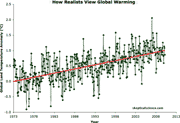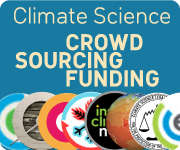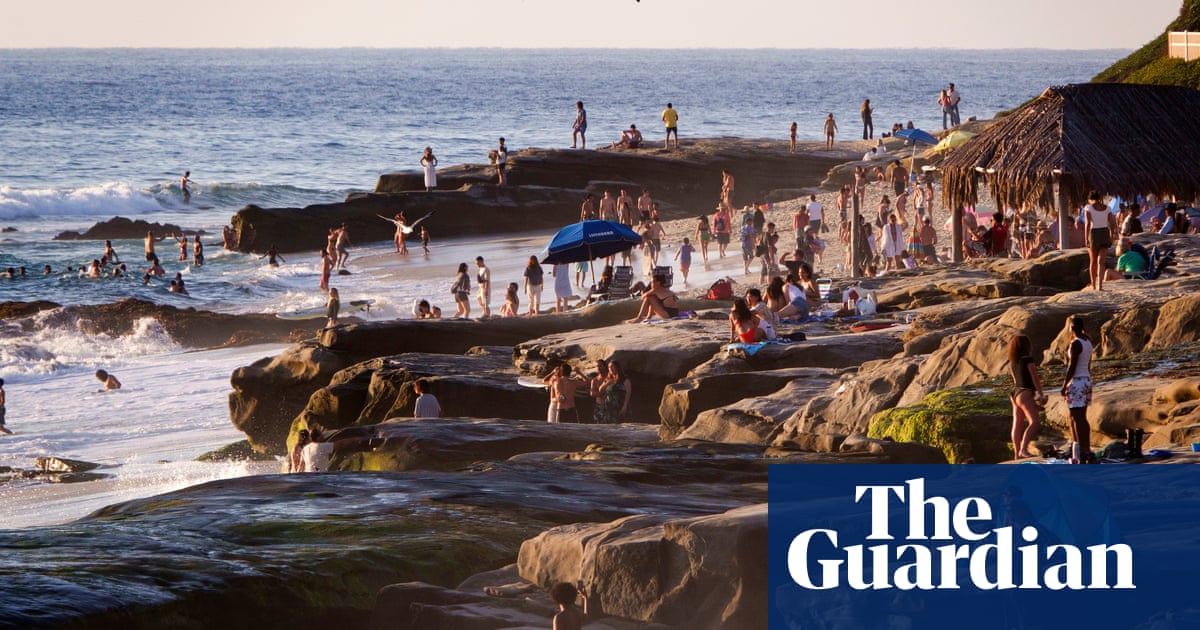PROTECT YOUR DNA WITH QUANTUM TECHNOLOGY
Orgo-Life the new way to the future Advertising by Adpathway

Latest Posts
- Skeptical Science New Research for Week #43 2025
- New Book - Climate Obstruction: A global Assessment
- 50 fact briefs published in collaboration with Gigafact!
- India’s power-sector CO2 falls for only second time in half a century
- 2025 SkS Weekly Climate Change & Global Warming News Roundup #42
- Skeptical Science New Research for Week #42 2025
- Fact-checking a Trump administration claim about climate change and crops
- Fact brief - Does increasing CO2 have a noticeable effect?
- Most of the world has recently set all-time heat records
- 2025 SkS Weekly Climate Change & Global Warming News Roundup #41
- The Cranky Uncle game can now be played in 17 languages!
- Skeptical Science New Research for Week #41 2025
- Is this the most embarrassing error in the DOE Climate Working Group Report?
- Fact brief - Do errors in Al Gore's 'An Inconvenient Truth' disprove climate change?
- Climate Adam - Climate Scientist Reacts to Trump's UN Speech
- 2025 SkS Weekly Climate Change & Global Warming News Roundup #40
- Skeptical Science New Research for Week #40 2025
- The undeniable science of extreme weather
- Fact brief - Are humans responsible for climate change?
- Revisiting the Geoengineering Question
- 2025 SkS Weekly Climate Change & Global Warming News Roundup #39
- Skeptical Science New Research for Week #39 2025
- The Cartoon Villain's Guide to Killing Climate Action
- Fact brief - Has the IPCC overestimated climate change impacts?
- Koonin providing clarity on climate?
- 2025 SkS Weekly Climate Change & Global Warming News Roundup #38
- Getting involved with Climate Science via crowdfunding and crowdsourcing
- Skeptical Science New Research for Week #38 2025
- Climate change is accelerating, scientists find in ‘grim’ report
- Fact brief - Has the greenhouse effect been falsified?
Skeptical Science New Research for Week #43 2025
Posted on 23 October 2025 by Doug Bostrom, Marc Kodack
Open access notables

Transparency, reproducibility, and acknowledging uncertainty are meritorious attributes of science that differentiate it from other human endeavors, such as politics. But they can also be subverted. In the United States, an executive order from the Trump administration called Restoring Gold Standard Science illustrates how this can be achieved despite it being cloaked in language that most of the scientific community would enthusiastically support. The order seeks to “to ensure that federally funded research is transparent, rigorous, and impactful, and that Federal decisions are informed by the most credible, reliable, and impartial scientific evidence available,” and it has already informed the Environmental Protection Agency’s (EPA) revised procedures for conducting risk evaluations for chemicals already in commerce.
Equatorial Atlantic mid-depth warming indicates Atlantic meridional overturning circulation slowdown, Ren et al., Communications Earth & Environment
Based on ocean general circulation model (OGCM) experiments, we identify the mid-depth warming of 1000–2000 m in the equatorial Atlantic as a fingerprint of AMOC slowdown under anthropogenic warming. Subsurface downwelling signals of the declined AMOC propagate along the western boundary and across the equator as baroclinic Kelvin waves within one decade. Compared to surface proxies, the mid-depth equatorial temperature is a more reliable indicator for the AMOC intensity on decadal and longer timescales. The mid-depth warming in the equatorial Atlantic is also robustly detected in historical in situ observations, indicating that the AMOC already slowed down in the late 20th century.
A Risk-Risk Assessment of Climate Extremes: Comparing Greenhouse Gas Warming and Stratospheric Aerosol Injection in UKESM1, Wells & Haywood, Earth's Future
This study investigates the potential of Stratospheric Aerosol Injection (SAI), a solar climate intervention strategy, to mitigate climate extremes driven by greenhouse gas (GHG) emissions, comparing its effects to those of GHG-induced warming under the SSP5-8.5 scenario. Using the UKESM1 climate model and the GeoMIP G6controller scenario, we examine extreme temperature, precipitation, and fire risk indices in a risk-risk framework. The multi-latitude G6controller strategy, an improvement on the equatorial injection strategy G6sulfur, reduces global mean temperature from SSP5-8.5 to SSP2-4.5, significantly reducing temperature and precipitation extremes. Results show that G6controller effectively reduces temperature extremes relative to SSP5-8.5, especially in populated areas like Europe and South America, and reduces fire risk in high-risk areas, such as South America and southern Africa. While both scenarios project broad precipitation increases, G6controller moderates these without introducing new drying relative to SSP5-8.5, particularly in Southeast Asia. This study highlights G6controller's potential to lessen the magnitude of extreme climate events, offering insights into SAI's regional efficacy and highlighting the trade-offs between GHG warming with and without solar climate intervention.
Africa’s regional and local climate response to stratospheric aerosol injection characteristics, Kumi et al., Frontiers in Climate
Using climate simulations, this study assesses the potential impact of stratospheric aerosol injection (SAI) on projected mean and extreme temperature and precipitation across the continent. We analysed data from the Stratospheric Aerosol Geoengineering Large Ensemble (GLENS) project, which simulates a set of SAI experiments under RCP8.5 emission scenarios with SO2 injection into the tropical stratosphere at 22.8–25?km altitude (GLENS) and around 1?km above the tropopause (GLENS_low) and near the equator at around 20–25?km above ground (GLENS_eq). The results show that all SAI experiments (GLENS, GLENS_eq, and GLENS_low) exhibit substantial cooling effects, with GLENS_eq emerging as the most effective in reducing temperature extremes, particularly over Central and Southern Africa. However, despite successfully offsetting much of the RCP8.5-induced warming, the effectiveness of SAI varies across regions, leaving some regions, such as the Sahel and North Africa, with residual warming. In addition to its cooling effects, SAI could significantly alter precipitation patterns, introducing widespread drying and thereby reducing flood risks across the continent. While SAI could offset the projected increase in extreme precipitation under RCP8.5, it could simultaneously exacerbate drying trends over Central, Southern, and Northern Africa. These findings highlight critical trade-offs associated with SAI deployment, particularly for regions where agriculture and water resources depend heavily on rainfall, underscoring the need for regionally optimised geoengineering strategies that balance temperature moderation with hydrological stability. This study provides the first comparative analysis of tropical, equatorial, and low-altitude SAI impacts on the climate, revealing critical trade-offs for precipitation-dependent regions. The findings presented here are, however, specific to the SAI scenarios analysed (GLENS experiments), as a different SAI deployment scenario would lead to different conclusions.
Subtraction neglect in perceptions of climate action strategies, Suter et al., Journal of Environmental Psychology
Research suggests that individuals often overlook beneficial subtractive strategies when solving problems. Subtractive strategies, which include reducing demand for goods and services (e.g., reducing car use), have a high climate mitigation potential. Yet, these may be systematically overlooked in favor of additive strategies like adopting new technologies (e.g., buying an electric car). This Registered Report investigates subtraction neglect in the context of personal climate action. When asked to think of the most effective personal climate mitigation actions, does priming people to think about additive and subtractive strategies increase the likelihood that they suggest subtractive climate actions? We investigate this research question via an online experiment conducted in the United Kingdom. Participants who received a brief prompt introducing both strategy types proposed significantly more subtractive actions than those who were not made aware of additive and subtractive strategies. The findings suggest that raising awareness of subtractive strategies can shift attention toward underused yet impactful climate actions.
From this week's government/NGO section:
Greenhouse Gas Bulletin - No. 21, World Meteorological Organization
The levels of the three most abundant long-lived greenhouse gases (LLGHGs), carbon dioxide (CO2), methane (CH4) and nitrous oxide (N2O), reached new records in 2024. From 2023 to 2024, CO2 in the global surface atmosphere increased by 3.5 ppm,(1) the largest one-year increase since modern measurements began in 1957. This increase was driven by continued fossil CO2 emissions, enhanced fire emissions and reduced terrestrial/ocean sinks in 2024, which could signal a climate feedback. Given the dominant role of increasing atmospheric CO2 in global climate change, achieving net-zero anthropogenic CO2 emissions must be the focus of climate action. Sustaining and expanding greenhouse gas monitoring is critical to supporting such efforts.State of Climate Action 2025, Schumer et al., World Resources Institute
Published ahead of COP30, the authors translates the Paris Agreement temperature goal into actionable targets for 2030, 2035 and 2050 across the world’s highest-emitting sectors – power, buildings, industry, transport, forests and land, and food and agriculture – as well as specifies how quickly technological carbon dioxide and climate finance must scale up. The authors then assess recent progress made towards these global benchmarks, highlighting where – and by how much – efforts must accelerate this decade. The authors found that, while the 10 years following the adoption of the Paris Agreement have seen the transition to net-zero emissions take off, there’s still a long way to go. Across every single sector, climate action has failed to materialize at the pace and scale required to achieve the Paris Agreement’s temperature goal. None of the 45 indicators assessed are on track to reach their 1.5°C-aligned targets by the end of this decade.125 articles in 54 journals by 755 contributing authors
Physical science of climate change, effects
Equatorial Atlantic mid-depth warming indicates Atlantic meridional overturning circulation slowdown, Ren et al., Communications Earth & Environment Open Access 10.1038/s43247-025-02793-1
Impact of Cold Wakes on Tropical Cyclone Rainfall under Global Warming, Chen et al., Journal of Climate 10.1175/jcli-d-25-0104.1
Leading dynamical processes of global marine heatwaves in an ocean state estimate, Sala et al., Ocean Science Open Access 10.5194/os-21-2463-2025
Rapid 21st Century Warming in the Southern Subtropical Indian Ocean Driven by Altered Inter-Basin Connections, Sajidh et al., International Journal of Climatology 10.1002/joc.70157
Reply to: Uncertain climate effects of anthropogenic reactive nitrogen, Gong et al., Nature Open Access 10.1038/s41586-025-09338-8
Uncertain climate effects of anthropogenic reactive nitrogen, Hodnebrog et al., Nature Open Access 10.1038/s41586-025-09337-9
Observations of climate change, effects
Amplified warming and marine heatwaves in the North Sea under a warming climate and their impacts, Mohamed et al., Ocean Science Open Access 10.5194/os-21-2505-2025
Compound Marine Heatwaves and Acidity Extremes in the Southern Ocean, Wong et al., Global Biogeochemical Cycles Open Access 10.1029/2025gb008630
Concurrent Heatwaves and Droughts in Canada: Spatio-Temporal Changes, Climate Drivers, and Persistence Properties, Sinha et al., Earth's Future Open Access 10.1029/2025ef006104
Contrasting trends of extreme rainfall and snowfall in the Northern Hemisphere, Li et al., Advances in Climate Change Research Open Access 10.1016/j.accre.2025.09.002
Increased Start-to-Peak Vegetation Growth is Associated With Spring Phenology Across the Northern Hemisphere, Wei et al., Global Biogeochemical Cycles 10.1029/2025gb008649
More than a century of oceanic hydrography observations reveals profound climate-related changes in the Northwest Atlantic and Eastern Arctic, Coyne et al., Open Access 10.5194/essd-2025-611
Rapid retreat of Berry Glacier, West Antarctica, linked to seawater intrusions revealed by radar interferometry, Chen et al., Nature Communications Open Access 10.1038/s41467-025-64330-0
Rapidly Changing Lake-Terminating Glaciers in High Mountain Asia: A Dataset from 1990 to 2022, Luo et al., Open Access 10.5194/essd-2025-596
Sea ice in the Baltic Sea during 1993/94–2020/21 ice seasons from satellite observations and model reanalysis, Singh et al., Open Access pdf 10.5194/egusphere-2024-1701
Weather and climate extremes in a changing Arctic, Zhang et al., Nature Reviews Earth & Environment Open Access 10.1038/s43017-025-00724-4
Instrumentation & observational methods of climate change, effects
Drought attribution of climate drivers using machine learning techniques, Speer & Leslie, Weather and Climate Extremes 10.1016/j.wace.2025.100801
Global ocean surface heat fluxes revisited: A new dataset from maximum entropy production framework with heat storage and Bowen ratio optimizations, Yang et al., Open Access 10.5194/essd-2024-420
Observation error estimation in climate proxies with data assimilation and innovation statistics, Okazaki et al., Climate of the Past Open Access 10.5194/cp-21-1801-2025
On the Measurement of Ocean Acidity With Ambient Sound, Uzhansky et al., Journal of Geophysical Research: Oceans Open Access 10.1029/2025jc022575
Relevance of earth observations of essential climate variables in wildfire adaptation, Seitzinger et al., Remote Sensing of Environment Open Access 10.1016/j.rse.2025.115082
Towards annual updating of forced warming to date and constrained climate projections, Ribes et al., Nature Communications Open Access 10.1038/s41467-025-63026-9
Modeling, simulation & projection of climate change, effects
A Risk-Risk Assessment of Climate Extremes: Comparing Greenhouse Gas Warming and Stratospheric Aerosol Injection in UKESM1, Wells & Haywood, Earth's Future Open Access 10.1029/2024ef005810
Atmospheric rivers emerge as future freshwater reserves and heat stocks, Lu et al., Communications Earth & Environment Open Access 10.1038/s43247-025-02780-6
Constrained Estimates of Externally Forced Past and Future Warming for Canada, Li et al., Earth's Future Open Access 10.1029/2025ef006374
Southern Ocean Heat Burp in a Cooling World, Frenger et al., AGU Advances Open Access 10.1029/2025av001700
Southern Ocean influence on Atlantic Meridional Overturning Circulation across climate states, Song et al., Nature Communications Open Access 10.1038/s41467-025-64268-3
Advancement of climate & climate effects modeling, simulation & projection
Advancing convection-permitting regional climate modeling for monsoon extremes in data-scarce, topographically complex regions of South Asia, Hassan et al., Atmospheric Research 10.1016/j.atmosres.2025.108486
An improved and extended parameterization of the CO2 15 µm cooling in the middle and upper atmosphere (CO2&cool&fort-1.0), López-Puertas et al., Geoscientific Model Development Open Access 10.5194/gmd-17-4401-2024
Drivers of Model Spread in Snowpack Changes across the American Mountain West, Aerenson et al., Journal of Climate 10.1175/jcli-d-25-0103.1
Estimating return periods for extreme events in climate models through Ensemble Boosting, Bloin-Wibe et al., Open Access 10.5194/egusphere-2025-525
Faster Soil Carbon Aging With Depth at Higher Elevations in a Subtropical Forest, Li et al., Global Biogeochemical Cycles 10.1029/2025gb008633
Integrating statistical distributions with machine learning to model IDF curve shifts under future climate pathways, Bakheit Taha et al., Frontiers in Environmental Science Open Access 10.3389/fenvs.2025.1671320
Cryosphere & climate change
Accelerated soil phosphorus cycling upon abrupt permafrost thaw, Li et al., Nature Climate Change 10.1038/s41558-025-02445-4
Damage development on Antarctic ice shelves sensitive to climate warming, Izeboud et al., Nature Climate Change 10.1038/s41558-025-02453-4
Modeling the impacts of climate trends and lake formation on the retreat of a tropical Andean glacier (1962–2020), Shutkin et al., Open Access 10.5194/egusphere-2024-3194
Rapid retreat of Berry Glacier, West Antarctica, linked to seawater intrusions revealed by radar interferometry, Chen et al., Nature Communications Open Access 10.1038/s41467-025-64330-0
Rapidly Changing Lake-Terminating Glaciers in High Mountain Asia: A Dataset from 1990 to 2022, Luo et al., Open Access 10.5194/essd-2025-596
Sea ice in the Baltic Sea during 1993/94–2020/21 ice seasons from satellite observations and model reanalysis, Singh et al., Open Access pdf 10.5194/egusphere-2024-1701
Spatio-temporal melt and basal channel evolution on Pine Island Glacier ice shelf from CryoSat-2, Lowery et al., Open Access 10.5194/egusphere-2025-267
The Critical Role of Snowmelt Onset-Driven Vapor Pressure Deficit Variations in Wildfire Dynamics of Northern Latitudes, Xu et al., Earth's Future Open Access 10.1029/2025ef006367
Sea level & climate change
Reconstructing sea level rise from global 945 tide gauges since 1900, Mu et al., Earth System Science Data Open Access 10.5194/essd-17-5507-2025
Biology & climate change, related geochemistry
A heat-sensitive songbird’s risk of lethal hyperthermia increases with humidity, Liddle et al., Biology Letters 10.1098/rsbl.2025.0284
A thorny future for sea urchins in the tropical Western Atlantic, Principe et al., Biodiversity and Conservation 10.1007/s10531-025-03161-3
Climate change impacts the non-market value of nature: A case study of birding cultural ecosystem services in South Africa, Manley et al., PLOS Climate Open Access 10.1371/journal.pclm.0000715
Climate change is predicted to reduce global belowground ecosystem multifunctionality, Zhou et al., Nature Communications Open Access 10.1038/s41467-025-64453-4
Climate Change, Fisheries Management, and Increases in Demersal Fish Distribution in a Southern Ocean Biodiversity Hotspot, Williams et al., Open Access 10.1101/2025.05.27.656478
Decades of Change in Vascular Plant Composition in High-Latitude Ecosystems: Shifting Prevalence of Pollination Strategies, Kiilunen et al., Ecology and Evolution Open Access 10.1002/ece3.72288
Declining ocean greenness and phytoplankton blooms in low to mid-latitudes under a warming climate, Hong et al., Science Advances Open Access 10.1126/sciadv.adx4857
Differential vegetation drought adaptability in global karst areas, He et al., npj Climate and Atmospheric Science Open Access 10.1038/s41612-025-01223-5
Effects of heat stress on the pectoral skeletal muscle of the Antarctic icefish Chionodraco hamatus and the red-blooded Trematomus bernacchii, Garofalo et al., Marine Environmental Research 10.1016/j.marenvres.2025.107573
Establishing ring width and cell chronologies for predicting future growth of Thuja koraiensis under climate change, Park et al., Dendrochronologia 10.1016/j.dendro.2025.126423
Evolutionary history of stony corals suggests that some could be resilient to climate change, , Nature 10.1038/d41586-025-03362-4
Global Warming and the Spread of the Introduced Jellyfish Cassiopea andromeda: Thermal Niche and Habitat Suitability in the Mediterranean Sea, Fumarola et al., Global Change Biology Open Access 10.1111/gcb.70548
Inevitable global coral reef decline under climate change-induced thermal stresses, Zeng et al., Communications Earth & Environment Open Access 10.1038/s43247-025-02790-4
Integrating Adaptive Capacity Alters Outcomes When Modelling Effects of Warming on a Cold-Water Fish in a Sub-Arctic Ecosystem, Mochnacz et al., Diversity and Distributions Open Access 10.1111/ddi.70097
Long-Term Incubation Duration Decline Indicates Climate-Change Driven Feminization of Three Sea Turtle Species in Florida, USA, Ceriani & Casale, Global Change Biology Open Access 10.1111/gcb.70559
Modeling Mycorrhizal Carbon Costs in Temperate Forests: The Impacts of Functional Diversity and Global Change Factors, Shao et al., Journal of Geophysical Research: Biogeosciences 10.1029/2025jg009198
Understanding the effects of recent atmospheric heatwaves on seagrass-inhabited intertidal shellfish beds: a mesocosm experiment, Román et al., Marine Environmental Research 10.1016/j.marenvres.2025.107547
Vulnerability to Climate Changes of Tropical Forests Across Africa, Madingou et al., Diversity and Distributions Open Access 10.1111/ddi.70104
Weather drivers of reproductive variability in perennial plants and their implications for climate change risks, Journé et al., Nature Communications Open Access 10.1038/s41467-025-64300-6
GHG sources & sinks, flux, related geochemistry
Application of PRIM for understanding patterns in carbon dioxide model-observation differences, Gerken et al., Atmospheric Chemistry and Physics Open Access 10.5194/acp-25-13327-2025
From Sink to Source: Salinity and Water Level Fluctuations Between Years Drive Large Differences in CO2 Exchange in a Temperate Salt Marsh, Lu et al., 10.22541/essoar.174886116.60567818/v1
Global climate mode resonance due to rapidly intensifying El Niño-Southern Oscillation, Stuecker et al., Nature Communications Open Access 10.1038/s41467-025-64619-0
Greenhouse Gas Emissions From a Large and Shallow Tropical African Lake: Contribution of Different Gases and Emission Pathways, Ague et al., Journal of Geophysical Research: Biogeosciences Open Access 10.1029/2024jg008572
Increased Belowground Carbon Allocation Reduces Soil Carbon Losses Under Long-Term Warming, Schindlbacher et al., Global Change Biology Open Access 10.1111/gcb.70561
Increasing soil organic carbon stock of alpine wetlands on the Tibetan Plateau: Results of future scenarios, Jiang et al., Global and Planetary Change 10.1016/j.gloplacha.2025.105104
Microbial oxidation significantly reduces methane export from global groundwaters, Heinze et al., Proceedings of the National Academy of Sciences Open Access 10.1073/pnas.2508773122
Southern Ocean freshening stalls deep ocean CO2 release in a changing climate, Olivier & Haumann Haumann, Nature Climate Change Open Access 10.1038/s41558-025-02446-3
Spatial and temporal variations of gross primary production simulated by land surface model BCC&AVIM2.0, Li et al., Advances in Climate Change Research Open Access 10.1016/j.accre.2023.02.001
CO2 capture, sequestration science & engineering
Carbon storing in United States cities through biogenic storage and concrete carbonation in the built environment, Hu & Ghorbany, Communications Earth & Environment Open Access 10.1038/s43247-025-02788-y
Impulse response functions as a framework for quantifying ocean-based carbon dioxide removal, Yankovsky et al., Biogeosciences Open Access 10.5194/bg-22-5723-2025
Pine afforestation on degraded lands: a global review of carbon sequestration potential, Tudor et al., Frontiers in Forests and Global Change Open Access 10.3389/ffgc.2025.1648094
Stakeholders have knowledge priorities beyond local impacts for responsible marine-based carbon dioxide removal in Tasmania, Malakar et al., Communications Earth & Environment Open Access 10.1038/s43247-025-02775-3
Toward green steel: Role of pilot-scale carbon capture and utilization technologies, Rathore, Energy for Sustainable Development 10.1016/j.esd.2025.101866
Decarbonization
Closed-loop geothermal system is a potential source of low-carbon renewable energy, Zargartalebi et al., Communications Earth & Environment Open Access 10.1038/s43247-025-02729-9
Global hidden material flows triggered by China’s vehicle supply chain far exceed eventual material use, Wang et al., Nature Communications Open Access 10.1038/s41467-025-64090-x
Let's meet at the (climate) club: The contributions of the Global Bioenergy Partnership (GBEP) to sustainable bioenergy governance, Afionis, Energy Research & Social Science Open Access 10.1016/j.erss.2025.104384
Geoengineering climate
A Risk-Risk Assessment of Climate Extremes: Comparing Greenhouse Gas Warming and Stratospheric Aerosol Injection in UKESM1, Wells & Haywood, Earth's Future Open Access 10.1029/2024ef005810
Africa’s regional and local climate response to stratospheric aerosol injection characteristics, Kumi et al., Frontiers in Climate Open Access 10.3389/fclim.2025.1599405
Effect of stratospheric aerosol injection on marine heatwave events off the coast of South Africa, Dimoune et al., Scientific Reports Open Access 10.1038/s41598-025-20672-9
Simulated Climate and Carbon Cycle Response to Arctic Ocean Albedo Modification, Jiang et al., Earth's Future Open Access 10.1029/2025ef006212
Climate change communications & cognition
Energy narratives in Europe: Exploring the link between online news and renewable energy production, Vestrelli et al., Energy Research & Social Science Open Access 10.1016/j.erss.2025.104345
From consensus gap to common ground: Causes knowledge as a crucial predictor of climate change perceptions across divides, Leoniak & Korniluk, Journal of Environmental Psychology 10.1016/j.jenvp.2025.102796
Mind the gap: bringing adolescents and young adults and emotional resilience into climate action, Kohli et al., Frontiers in Climate Open Access 10.3389/fclim.2025.1657851
Social media discourse as a window into energy transition: Analyzing public perception of electric vehicles on YouTube, Li & Ullah, Energy Research & Social Science 10.1016/j.erss.2025.104402
Subtraction neglect in perceptions of climate action strategies, Suter et al., Journal of Environmental Psychology Open Access 10.1016/j.jenvp.2025.102793
The Climate's Nuanced Truth: Why Past Disasters Fail to Ignite Action, Adolfo, Journal of Environmental Psychology 10.1016/j.jenvp.2025.102810
The populist roadblock: The Alternative for Germany (AfD), climate denial, and electric vehicle adoption in Germany, Stefes & Gabehart, Energy Research & Social Science 10.1016/j.erss.2025.104401
What is greenwashing- a scoping review of greenwashing definitions and development of the need-for- balance model, Koch & Denner, Journal of Sustainable Business Open Access 10.1186/s40991-025-00124-3
Agronomy, animal husbundry, food production & climate change
Global overview of agrivoltaic system: The future security for food and energy, Patel & Chakraborty, Energy for Sustainable Development 10.1016/j.esd.2025.101870
Modeling biochar effects on soil organic carbon on croplands in a microbial decomposition model (MIMICS-BC&v1.0), Han et al., Geoscientific Model Development Open Access 10.5194/gmd-17-4871-2024
Modeling climate-resilient crop suitability in central India using machine learning and species distribution approaches, Moharana et al., Theoretical and Applied Climatology 10.1007/s00704-025-05838-9
Hydrology, hydrometeorology & climate change
A Meta-Analysis to Disentangle the Impacts of Climate and Land Use Changes on Streamflow, Soundharajan et al., Earth's Future Open Access 10.1029/2024ef005757
Atmospheric rivers emerge as future freshwater reserves and heat stocks, Lu et al., Communications Earth & Environment Open Access 10.1038/s43247-025-02780-6
Contrasting trends of extreme rainfall and snowfall in the Northern Hemisphere, Li et al., Advances in Climate Change Research Open Access 10.1016/j.accre.2025.09.002
Amplified warming and marine heatwaves in the North Sea under a warming climate and their impacts, Mohamed et al., Ocean Science Open Access 10.5194/os-21-2505-2025
Compound Marine Heatwaves and Acidity Extremes in the Southern Ocean, Wong et al., Global Biogeochemical Cycles Open Access 10.1029/2025gb008630
Concurrent Heatwaves and Droughts in Canada: Spatio-Temporal Changes, Climate Drivers, and Persistence Properties, Sinha et al., Earth's Future Open Access 10.1029/2025ef006104
Contrasting trends of extreme rainfall and snowfall in the Northern Hemisphere, Li et al., Advances in Climate Change Research Open Access 10.1016/j.accre.2025.09.002
Increased Start-to-Peak Vegetation Growth is Associated With Spring Phenology Across the Northern Hemisphere, Wei et al., Global Biogeochemical Cycles 10.1029/2025gb008649
More than a century of oceanic hydrography observations reveals profound climate-related changes in the Northwest Atlantic and Eastern Arctic, Coyne et al., Open Access 10.5194/essd-2025-611
Rapid retreat of Berry Glacier, West Antarctica, linked to seawater intrusions revealed by radar interferometry, Chen et al., Nature Communications Open Access 10.1038/s41467-025-64330-0
Rapidly Changing Lake-Terminating Glaciers in High Mountain Asia: A Dataset from 1990 to 2022, Luo et al., Open Access 10.5194/essd-2025-596
Sea ice in the Baltic Sea during 1993/94–2020/21 ice seasons from satellite observations and model reanalysis, Singh et al., Open Access pdf 10.5194/egusphere-2024-1701
Weather and climate extremes in a changing Arctic, Zhang et al., Nature Reviews Earth & Environment Open Access 10.1038/s43017-025-00724-4
Modeling snowmelt-driven streamflow dynamics in a Himalayan Basin under climate warming scenarios, Jamshed et al., PLOS Climate Open Access 10.1371/journal.pclm.0000739
Two sides of the same coin? Hydrometeorological uncertainties in impact-based flood warning systems and climate change sensitivity of floodplains, Mosimann et al., Weather and Climate Extremes Open Access 10.1016/j.wace.2025.100817
Climate change economics
Decoupling carbon emissions, economic growth, and health costs toward carbon neutrality in China's regions, Huang et al., Energy for Sustainable Development 10.1016/j.esd.2025.101789
Mitigation efforts to reduce carbon dioxide emissions and meet the Paris Agreement have been offset by economic growth, Jiang et al., Communications Earth & Environment Open Access 10.1038/s43247-025-02743-x
Climate change mitigation public policy research
Beyond individual barriers: a systems approach to understanding and addressing nature-based solutions implementation challenges, Han et al., Climate Risk Management Open Access 10.1016/j.crm.2025.100739
Driving carbon offset donations: Evaluating the effectiveness of nudging, framing, and Nudge+ techniques, Effendy et al., Journal of Environmental Psychology 10.1016/j.jenvp.2025.102758
Enhancing carbon emission reduction strategies using OCO and ICOS data, Åström et al., Scientific Reports Open Access 10.1038/s41598-025-22022-1
Housing exchange framework to reduce carbon emissions from commuting, Zhao et al., Nature Sustainability Open Access 10.1038/s41893-025-01658-x
Lifestyle change modelling for climate change mitigation: Complementary strengths, policy support, and research avenues, Scherer et al., Environmental Science & Policy Open Access 10.1016/j.envsci.2025.104256
Smart thermostats, washing machines, and electric vehicle charging: Determinants of preferences among German and Spanish consumers, Amaris et al., Energy Research & Social Science Open Access 10.1016/j.erss.2025.104344
Subtraction neglect in perceptions of climate action strategies, Suter et al., Journal of Environmental Psychology Open Access 10.1016/j.jenvp.2025.102793
The climate mitigation effect of legal institutions: environmental courts and urban carbon balance, Long et al., Frontiers in Environmental Science Open Access 10.3389/fenvs.2025.1622148
The fuel of the future law and the Brazilian sugarcane energy sector, Lisbinski et al., Energy Policy 10.1016/j.enpol.2025.114889
The impact of wealth inequality on carbon emissions and climate policy, Morrison et al., Climate Policy 10.1080/14693062.2025.2571400
Climate change adaptation & adaptation public policy research
A framework-based assessment of climate adaptation readiness in Romanian cities, Falcescu et al., Climate Policy 10.1080/14693062.2025.2570741
Accessibility analysis and optimization strategies of green spaces for enhancing climate resilience: Equity-oriented insights from megacities, Zhang et al., Environmental Science & Policy 10.1016/j.envsci.2025.104234
An intersectional analysis of climate risk and susceptibility among urban schools across 20 major U.S. cities, Rahai et al., Urban Climate 10.1016/j.uclim.2025.102620
Co-producing climate services for urban adaptation: what shapes perspectives of success?, Boon & Biesbroek, Urban Climate Open Access 10.1016/j.uclim.2025.102654
Comprehensive portfolio of adaptation measures to safeguard against evolving flood risks in a changing climate, Azhar et al., Communications Earth & Environment Open Access pdf 10.1038/s43247-025-02779-z
Critical intervention points for European adaptation to cascading climate change impacts, Auer et al., Nature Climate Change Open Access 10.1038/s41558-025-02455-2
Framework for assessing the climate vulnerability of unpaved roads in Sierra Leone, Kamara et al., Frontiers in Climate Open Access 10.3389/fclim.2025.1608176
Identifying critical intervention points for the prevention of cascading climate impacts, , Nature Climate Change 10.1038/s41558-025-02456-1
Mapping the solution space for local adaptation under global change: A test of concept for the Vietnamese Mekong delta, Dunn et al., Global Environmental Change Open Access 10.1016/j.gloenvcha.2025.103071
The ambiguity of “climate change adaptation” and financing decisions in public budgets: insights from Tanzania, Pauline et al., Climate and Development 10.1080/17565529.2025.2575472
Climate change impacts on human health
Climate change, marriage and health, Chuang & Capellan , Frontiers in Climate Open Access 10.3389/fclim.2025.1665070
Climate-Driven Increase in Transmission of a Wildlife Malaria Parasite Over the Last Quarter Century, Theodosopoulos et al., Open Access 10.1101/2025.03.25.644544
Long-term trends in extreme heat exposure equity for children and elderly: A case study of Shandong Peninsula urban agglomeration, Li et al., Urban Climate 10.1016/j.uclim.2025.102587
Urban heat risks reimagined: A framework for global physical hazard assessment, Hung et al., Urban Climate 10.1016/j.uclim.2025.102659
Climate change impacts on human culture
Sustainable Strategies for Optimizing the Reduction of GHG Emissions in Qatar's Football Stadiums, Alaoui & Zarraa, Greenhouse Gases: Science and Technology 10.1002/ghg.2363
Other
Climate philanthropy as a catalyst for advancing the renewable energy transition and climate resilience in Africa, Kwanhi et al., Frontiers in Climate Open Access 10.3389/fclim.2025.1651147
Key challenges in forest restoration and adaptation in Spain: Expert-based solutions for a resilient future, Erdozain et al., Environmental Science & Policy Open Access 10.1016/j.envsci.2025.104238
Stakeholder asset-mapping of climate technology infrastructures, Koch, Nature Reviews Earth & Environment 10.1038/s43017-025-00737-z
Informed opinion, nudges & major initiatives
Trojan gold: New US “standard” is another veiled attack on science, Lewandowsky, Science 10.1126/science.aeb9857
Articles/Reports from Agencies and Non-Governmental Organizations Addressing Aspects of Climate Change
Delivering on the UAE Consensus: Tracking progress toward tripling renewable energy capacity and doubling energy efficiency by 2030, Xiao et al., International Renewable Energy Agency, COP30 Presidency, Global Renewables Alliance, Abu Dhabi
The authors found that the UAE Consensus target to reach 11.2 TW of installed renewable power capacity by 2030 remains within reach, thanks to record-breaking capacity additions for a third consecutive year in 2024. Yet, imbalances in the technologies installed and their geographic deployment continue to threaten an effective, just and inclusive transition.Gallagher Re Natural Catastrophe and Climate Report: Q3 2025, Bowen et al., Gallagher Re
The authors summarize preliminary global loss totals and major catastrophe events that occurred during the first three quarters of 2025. Global natural catastrophe activity remained relatively mild during the third quarter of 2025. The abnormally low frequency of high-cost events has, thus far, left the year within annual catastrophe budgets for governments and the insurance industry. The minimum USD $214 billion in economic losses from all natural perils was notably below the 10-year average (USD $338 billion). The portion covered by the insurance market or public insurance entities was at least USD $105 billion, or 8% lower than the decadal average (USD $114 billion). The below average loss totals are largely due to quieter-than-expected tropical cyclone activity in the Atlantic and Pacific oceans.The Cost & Carbon of Competing Utility Models, Denise Grab, Emmett Institute on Climate Change and the Environment, University of California, Los Angeles
The author presents a case study of two specific utilities in the same geographic region: the Los Angeles Department of Water & Power (LADWP) and Southern California Edison (SCE). What do the outcomes in Los Angeles tell us about how the two types of utility models can achieve clean energy goals? What about cost? The author examines climate metrics, residential rates, percentage of Renewable Portfolio Standard (RPS)-eligible generation, and carbon intensity of the overall generation mix, among other measures. Overall, LADWP and SCE appear to be converging on both climate and cost outcomes, but there are notable differences between the two models which the author explores.Smoke screen: the growing PHEV emissions scandal. Long-range PHEVs and EREVs are a diversion on the road to zero emissions, Sofía Navas Gohlke and Yoann Gimbert, Transport & Environment
In 2026, the European Commission (EC) will review the car CO? emission standards - EU’s flagship automotive climate and industrial policy. While the EC prepares for the review, the automotive industry is calling to weaken the regulation, notably by calling to prolong the sales of plug-in hybrid electric vehicles (PHEVs) beyond 2035 and to reverse the correction of the official PHEV emissions based on utility factors. A specific variant of PHEV, extended-range electric vehicles (EREVs), which are becoming increasingly popular in China, have also entered the debate. The authors shed light on the risks posed by PHEVs, highlighting the crucial importance of upholding the planned utility factor corrections and shows that PHEVs are not future-proof options for European drivers and the European automotive industry. The real-world CO? emissions of PHEV models registered in 2023 are nearly five times the official emissions. This real-world gap has been widening over the years from 3.5 in 2021 to 4.9 in 2023 based on official data transmitted from on-board fuel consumption meters (OBFCM). The gap is mostly caused by flawed assumptions on the share of electric driving mode (the ‘utility factor’, UF) which leads to a drastic underestimate of official PHEV emissions. The UF overestimated the electric driving share, assuming 84% over 2021-2023, whereas real-world data shows this to be just 27%.Greenhouse Gas Bulletin - No. 21, World Meteorological Organization
The levels of the three most abundant long-lived greenhouse gases (LLGHGs), carbon dioxide (CO2), methane (CH4) and nitrous oxide (N2O), reached new records in 2024. From 2023 to 2024, CO2 in the global surface atmosphere increased by 3.5 ppm,(1) the largest one-year increase since modern measurements began in 1957. This increase was driven by continued fossil CO2 emissions, enhanced fire emissions and reduced terrestrial/ocean sinks in 2024, which could signal a climate feedback. Given the dominant role of increasing atmospheric CO2 in global climate change, achieving net-zero anthropogenic CO2 emissions must be the focus of climate action. Sustaining and expanding greenhouse gas monitoring is critical to supporting such efforts.Comprehensive Climate Action Plan. Washington-Arlington-Alexandria DC-VA-MD-WV Metropolitan Statistical Area, Metropolitan Washington Council of Governments, Washington DC Department of Energy and Environment
The authors present 10 vital measures to reduce air pollution and greenhouse gas emissions in the Metropolitan Statistical Area (MSA). These measures were developed through a collaborative and iterative process with the many government offices and committees within the MSA and the states it crosses, as well as other stakeholders such as community-based organizations, private sector actors, utilities, planning boards and committees, and more. These are practical and achievable strategies spanning buildings and clean energy, transportation, waste, and land-use sectors.Effect of no-till on carbon balance and greenhouse gas emissions in boreal mineral and peat soils, Henri Honkanen, University of Helsinki
Intensive cultivation of soils has increased greenhouse gas (GHG) emissions and soil organic carbon (SOC) losses from arable soils. In particular, peat soils are a major GHG emission source even though their share of total agricultural area is small. The widely adopted no-tillage (NT) method has many benefits, such as reduced workload and erosion. However, the benefits of NT for climate change mitigation remain unclear. This thesis focused on increasing understanding of carbon cycling and the formation of GHG emissions and elucidated the potential of NT in climate change mitigation in boreal climate conditions.Canadians Back Carbon Removal, Carbon Removal Canada
The authors show that there is significant public support for carbon removal. Nearly two-thirds of Canadians (64%) support carbon removal initiatives, while four in five (81%) consider removals essential to building a strong future for the country. The results coincide with federal and provincial efforts to advance carbon removal through tax credits, procurement, and innovation policy. Polling finds Canadians are ready for more of this kind of leadership. This support cuts across traditional political divides, with 77% of Liberal voters, 76% of NDP voters, and 51% of Conservative voters endorsing carbon removal. Regionally, Quebec (74%) and Ontario (68%) lead in support. Provincial motivations vary strategically—from innovation leadership resonating in British Columbia to agricultural co-benefits appealing to Saskatchewan and Manitoba, and climate resilience driving support in Atlantic Canada. More than half of Canadians (54%) report familiarity with durable carbon removal methods. Carbon removal support has also evolved beyond environmental policy into a leadership litmus test. Nearly two-thirds (62%) of Canadians say they are more likely to vote for candidates supporting these technologies, while 56% view companies more favorably when they invest in carbon removal.From Principles to Practice: Operationalization of a Global Carbon Market under Article 6, Hauman et al., The Oxford Institute for Energy Studies
While Article 6 and emerging regulatory standards have laid the structural groundwork for integrity of carbon markets, the real challenge now is operationalizing that framework. In the coming five years, project-based carbon credit markets are expected to undergo a decisive shift from voluntary and fragmented activity to large-scale, compliance-driven demand. Conservative projections indicate that annual demand for regulatory credits including for compliance use domestically and internationally will increase over fivefold between 2024 and 2030, underpinned by substantial sovereign commitments and new domestic legislation. This transition is constructive but not without its challenges. To support this market growth and beyond, it requires a step-change in project pipelines, transparent registries, coherent legal frameworks and bankable finance to convert commitments into deliverable supply. Without timely coordination and capacity building, project-based carbon credit markets risk mismatches between regulated demand and available supply, limiting the overall potential growth of these markets and therefore the opportunity for trade to enable quicker and more cost-effective decarbonization. The authors preview both the substantial progress already made since an earlier update alongside the future challenges to scale, setting out the practical areas in which policy, market and financial actors must align to enable a truly liquid, global regulated carbon market by 2030.Building Community Power. Community Benefits Agreements Across the Global Energy Supply Chain, Blair et al., The Climate and Community Institute
The authors conducted research spanning the globe on Community benefit Agreement (CBA) best practices, interviewed communities actively involved in CBA negotiations, and consulted preeminent scholars and practitioners of CBAs and the energy transition on policy design. The researchers found that when they strategically employ CBAs, communities can shape how burdens and benefits are distributed, how projects are designed and governed, and even whether or not a project moves forward at all. In fact, the entire supply chain of the energy transition—from extraction to processing, manufacturing, and transportation, as well as electric power generation, storage, and transmission—offers opportunities for cross-sectoral organizing and equitable governance.Global Multidimensional Poverty Index 2025 – Overlapping Hardships: Poverty and Climate Hazards, Alkire et al., United Nations Development Program and Oxford Poverty and Human Development Institute
The climate crisis is fundamentally changing global poverty. It has left more people than ever at risk of poverty and less likely to escape it. Inequalities have worsened while prospects for sustainable development recede. Climate shocks continue to grow in frequency and intensity, leaving a lengthening trail of human suffering and deprivation. Climate-related disasters pushed around 32 million people from their homes and communities in 2022 alone. Poverty, once seen as mainly a standalone socioeconomic concern, is now inextricably linked with planetary pressures. Without ambitious efforts to mitigate climate fallout, the number of people in extreme monetary poverty could nearly double by 2050. Poverty and climate shocks create a double burden. Poverty drives exposure to climate hazards. These, in turn, reinforce and prolong poverty. This interconnectedness is a defining characteristic of the Anthropocene, an era in which human activity has so fundamentally altered the Earth’s systems that environmental and social problems can only be resolved together. The authors, for the first time, overlay data on climate hazards and multidimensional poverty to assess how exposed poor people are to climate shocks.Ten Years of the Paris Agreement: The Present and Future of Extreme Heat, Arrighi et al., World Weather Attribution
The Paris Agreement provides an important legal and political framework toward a safer and fairer world. Projected warming this century has dropped from about 4°C in 2015 to 2.6°C today — if current emissions reduction pledges are fully implemented. However, 2.6°C of warming would still lead to a dangerously hot planet. Every fraction of a degree of warming results in more frequent and intense heat. The world now experiences an average of 11 more hot days per year with the additional 0.3°C of warming since 2015. In a 2.6°C world, that increases to 57 extra hot days per year compared to now; at 4°C, that rises to an additional 114 hot days per year. Case studies in the report confirm that extreme heat waves have already become more likely since 2015. Three of the six events studied would have been nearly impossible without climate change, and two of those are now about 10 times more likely to occur in 2025 than in 2015. Since 2015, heat early warning systems and action plans have expanded worldwide, but progress is insufficient and is slowed by limited financing for heat adaptation at the local level. The costs of inaction on extreme heat are rising faster than adaptation. Health, labor, and infrastructure are under strain, adaptation finance is insufficient, and the most vulnerable risk being left behind unprepared. The expected warming this century is still far above the Paris goals of keeping warming to 1.5°C and well below 2°C. The highest possible ambition as set out in the Paris Agreement to achieve deep, rapid, and sustained emissions reductions is urgently needed.Returns on Resilience: Investing in Adaptation to Drive Prosperity, Growth and Competitiveness, Schmidt-Traub et al., Africa Europe Foundation et al
Investing in climate and nature resilience could generate over 280 million jobs across emerging markets and developing economies by 2035, while boosting GDP and unlocking a trillion dollar market opportunity. THE authors present the strongest evidence to date that adaptation is not just a moral imperative, but a strategic investment in sustainable growth. Investments in adaptation deliver four times more benefits than costs, with an average annual return rate of 25%. Beyond avoided losses, resilience-building investments drive growth and competitiveness. Scaling interventions could create more than 280 million jobs by 2035. The adaptation and resilience market could reach up to $1.3 trillion annually by 2030. In some vulnerable economies, adaptation could increase GDP by up to 15% by 2050, while strengthening fiscal stability and reducing debt risk.Evaluation and Assessment of Local Government Processes for the Siting of Commercial Clean Energy and Energy Transmission Projects, Colorado Energy Office and Department of Natural Resources
The authors identify key challenges and best practices in siting and permitting new clean energy infrastructure. By identifying barriers as directed by SB24-212, the authors pave the way for further action to improve siting and permitting of clean energy projects to deliver affordable energy resources and meet increasing electricity demand.Navigating injustice, Amnesty International
As human-induced climate change threatens the human rights of people living in the Pacific, many seek opportunities to migrate to Aotearoa New Zealand. Sea level rise constitutes an existential threat for low-lying island countries projected to increasingly lose land to the encroaching ocean, such as Tuvalu and Kiribati. Coastal erosion, king tides, floods, extreme heat, droughts, and cyclones threaten Pacific Peoples’ rights to life, health, an adequate standard of living, and a clean, healthy and sustainable environment. The authors document how Aotearoa New Zealand’s immigration policy framework fails to reflect the needs of climate-affected Pacific peoples. The international community’s failure to act on climate change, coupled with states’ increasingly restrictive approaches to international migration, subjects people displaced in the context of the climate crisis to a double injustice. Aotearoa New Zealand – and the international community – must act now to protect the rights and dignity of Pacific peoples in the face of the climate crisis, both at home and in their country of destination.Connecting Early Childhood Development to Climate Change, Lyew et al., Frameworks, the Harvard Center on the Developing Child and Harvard Chan C-CHANGE
Climate change is typically framed as a future problem, but it is already reshaping the environments where children live, grow, play, and learn. Despite that reality, public attention is rarely focused on how climate change affects children’s development—or what we can do about it. The authors' offer practical guidance for advocates, researchers, organizers, and other communicators who can help shape conversations about climate change and child development. It includes an examination of how people currently think about these issues, an analysis of communication challenges, and recommendations for framing messages to build public understanding of the impacts of climate change on early childhood development.Draft Comprehensive Climate Action Plan (Hampton Roads, Virginia), The Hampton Roads Planning District Commission
This draft plan provides a roadmap for local governments, industry, and communities to work together toward net zero greenhouse gas (GHG) emissions by 2050. Climate action is not only about cutting carbon. The CCAP also aims to improve air quality and health by reducing co-pollutants, boost the clean energy economy and workforce development, protect vulnerable communities from flooding, heat, and rising energy costs, and preserve natural lands and waterways critical to Hampton Roads’ identity and safety.Roasting the Planet. Big Meat and Dairy’s Big Emissions, Greenpeace Nordic, Foodrise, Friends of the Earth and Institute for Agricultural and Trade Policy
The authors present the latest global assessment of the meat and dairy industry’s outsized climate impact, estimating the greenhouse gas (GHG) emissions generated by 45 of the world’s major meat and dairy processing companies in 2023. These 45 meat and dairy companies together emitted an estimated 1.02 billion tons CO2eq of GHG emissions in 2023. If they were a country, they would be the world’s ninth highest GHG-emitting nation. In fact, the companies’ combined emissions are estimated to be more than those reported for Saudi Arabia, reportedly the second largest oil producer in the world. The methane emissions from these 45 companies combined are estimated to be more than the reported methane of all the EU27 countries and UK combined in 2023. The top five emitters combined—JBS, Marfrig, Tyson, Minerva and Cargill—emitted an estimated 480 MtCO2eq of GHG emissions in 2023, more than reported for Chevron, Shell or BP27. The estimated emissions of these five companies combined account for nearly half (47%) of the estimated GHG emissions from the total of 45 meat and dairy companies analyzed.Accelerating sustainability in professional sport: Insights from rugby union, Wilson et al., Center for Climate Change and Social Transformations
Professional rugby union clubs in South Wales and South West England continue to work on reducing their carbon footprint and enhancing sustainable operations. Knowledge exchange forums provide an opportunity for clubs to share expertise, exchange best practices, and build networks that support collective action. Engaging rugby club staff, players, fans, and the local rugby community on climate and sustainability actions can foster a sense of partnership and shared identity. This should be supported by clear messaging on how these actions align with the club’s sustainability vision and strategy. Leveraging teamwork, commitment, and competitiveness among clubs and their fans can drive positive change. Drawing on the example of ‘green clubs’ in the English Football League, introducing a formal sustainability accreditation scheme could enable clubs to showcase their achievements and foster greater fan engagement. Clubs can collaborate to establish minimum sustainability standards in procurement, energy, and transport. Engaging key partners, such as league governing bodies, is crucial; however, the drive for systemic change can also come from clubs and their communities.State of Climate Action 2025, Schumer et al., World Resources Institute
Published ahead of COP30, the authors translates the Paris Agreement temperature goal into actionable targets for 2030, 2035 and 2050 across the world’s highest-emitting sectors – power, buildings, industry, transport, forests and land, and food and agriculture – as well as specifies how quickly technological carbon dioxide and climate finance must scale up. The authors then assess recent progress made towards these global benchmarks, highlighting where – and by how much – efforts must accelerate this decade. The authors found that, while the 10 years following the adoption of the Paris Agreement have seen the transition to net-zero emissions take off, there’s still a long way to go. Across every single sector, climate action has failed to materialize at the pace and scale required to achieve the Paris Agreement’s temperature goal. None of the 45 indicators assessed are on track to reach their 1.5°C-aligned targets by the end of this decade.About New Research
Click here for the why and how of Skeptical Science New Research.
Suggestions
Please let us know if you're aware of an article you think may be of interest for Skeptical Science research news, or if we've missed something that may be important. Send your input to Skeptical Science via our contact form.
Previous edition
The previous edition of Skeptical Science New Research may be found here.
THE ESCALATOR

(free to republish)






































 English (US) ·
English (US) ·  French (CA) ·
French (CA) ·